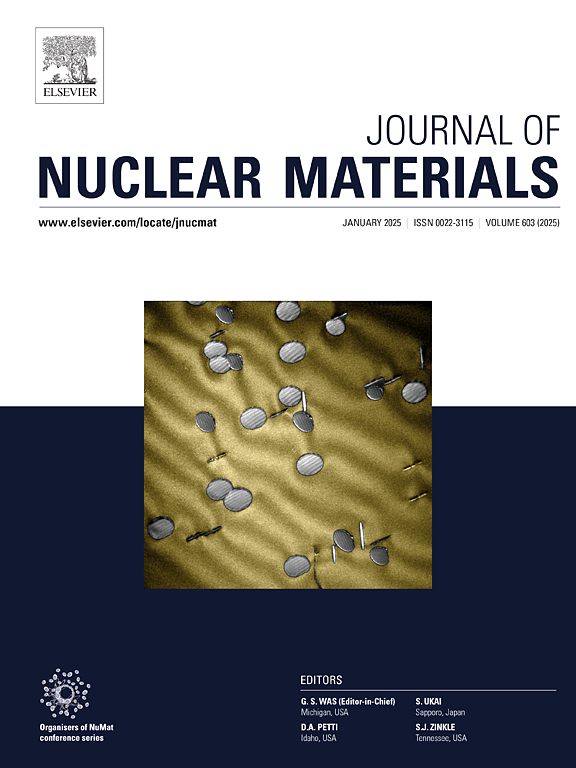Microstructural characterization of irradiated SrTiO3 using high-resolution STEM-EDS analysis
IF 2.8
2区 工程技术
Q3 MATERIALS SCIENCE, MULTIDISCIPLINARY
引用次数: 0
Abstract
To gain a deeper understanding of radiation-induced amorphization, high-resolution ABF/ADF and STEM-EDS techniques were utilized for the irradiation of single crystal SrTiO3 with 160 keV O+ at room temperature. The results show that oxygen column damage increased with irradiation dose, however, the local specific damage level was determined from the depth profiles of irradiation dose, dose rate, and amount of implanted oxygen at different fluences. HAADF observations indicated a decrease in Sr and Ti column intensities with increasing irradiation dose, initially monotonic, then slowing above 5 dpa and accelerating again above 30 dpa. This behavior suggests that the accumulation of topological and chemical disordering depends on the damage level. STEM-EDS analysis revealed periodic concentration changes of Sr and Ti based on the atomic arrangement of the crystal in unirradiated SrTiO3. By comparing irradiated and unirradiated samples, the concentration changes associated with oxygen implantation and the formation of chemical and topological disordering were confirmed. These results highlight the potential of STEM-EDS to characterize the evolution of irradiated microstructures in SrTiO3, even with a relatively low spatial resolution probe. Consequently, this study offers valuable insights into the mechanisms of radiation-induced instability of SrTiO3, contributing to the visualization of irradiation microstructure in various materials as well.
利用高分辨率STEM-EDS分析辐照SrTiO3的微观结构表征
为了更深入地了解辐射诱导的非晶化,利用高分辨率ABF/ADF和STEM-EDS技术在室温下用160 keV O+照射单晶SrTiO3。结果表明,氧柱损伤随辐照剂量的增加而增加,但局部特定损伤水平可通过不同影响下辐照剂量、剂量率和氧注入量的深度分布来确定。HAADF观测表明,随着辐照剂量的增加,Sr柱和Ti柱强度呈单调下降趋势,在5 dpa以上逐渐减缓,在30 dpa以上再次加速。这种行为表明,拓扑和化学无序的积累取决于损伤水平。STEM-EDS分析显示,在未辐照的SrTiO3中,基于晶体的原子排列,Sr和Ti的浓度发生周期性变化。通过对辐照样品和未辐照样品的比较,证实了氧注入和化学和拓扑无序形成相关的浓度变化。这些结果突出了STEM-EDS表征SrTiO3辐照微观结构演变的潜力,即使使用相对较低的空间分辨率探针。因此,该研究为SrTiO3辐射诱导不稳定性的机制提供了有价值的见解,也有助于可视化各种材料中的辐照微观结构。
本文章由计算机程序翻译,如有差异,请以英文原文为准。
求助全文
约1分钟内获得全文
求助全文
来源期刊

Journal of Nuclear Materials
工程技术-材料科学:综合
CiteScore
5.70
自引率
25.80%
发文量
601
审稿时长
63 days
期刊介绍:
The Journal of Nuclear Materials publishes high quality papers in materials research for nuclear applications, primarily fission reactors, fusion reactors, and similar environments including radiation areas of charged particle accelerators. Both original research and critical review papers covering experimental, theoretical, and computational aspects of either fundamental or applied nature are welcome.
The breadth of the field is such that a wide range of processes and properties in the field of materials science and engineering is of interest to the readership, spanning atom-scale processes, microstructures, thermodynamics, mechanical properties, physical properties, and corrosion, for example.
Topics covered by JNM
Fission reactor materials, including fuels, cladding, core structures, pressure vessels, coolant interactions with materials, moderator and control components, fission product behavior.
Materials aspects of the entire fuel cycle.
Materials aspects of the actinides and their compounds.
Performance of nuclear waste materials; materials aspects of the immobilization of wastes.
Fusion reactor materials, including first walls, blankets, insulators and magnets.
Neutron and charged particle radiation effects in materials, including defects, transmutations, microstructures, phase changes and macroscopic properties.
Interaction of plasmas, ion beams, electron beams and electromagnetic radiation with materials relevant to nuclear systems.
 求助内容:
求助内容: 应助结果提醒方式:
应助结果提醒方式:


